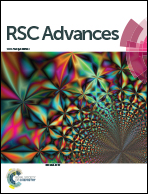Symmetric and unsymmetric thienyl-substituted fluorenone dyes: static excimer-induced emission enhancement†
Abstract
In this work, we designed and synthesized four symmetric and asymmetric thienyl-substituted fluorenone compounds, which all exhibited typical AIE properties. Besides a high solid-state fluorescence quantum yield, the enhanced luminescence of their solid-state powders showed a 170 nm red-shift (from 380 to 550 nm) in comparison with the luminescence of their dilute tetrahydrofuran solutions. The photophysical properties and single-crystal structure, combined with the theoretical calculation, revealed that the bathochromic luminescence is due to the formation of static excimers.



 Please wait while we load your content...
Please wait while we load your content...